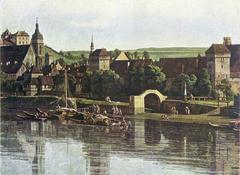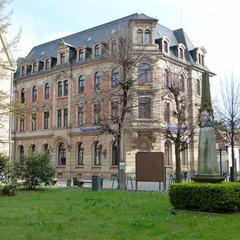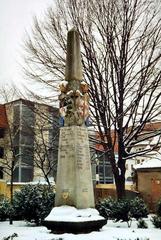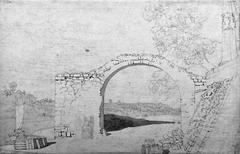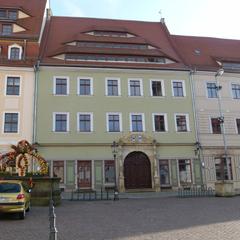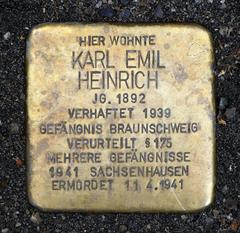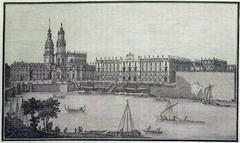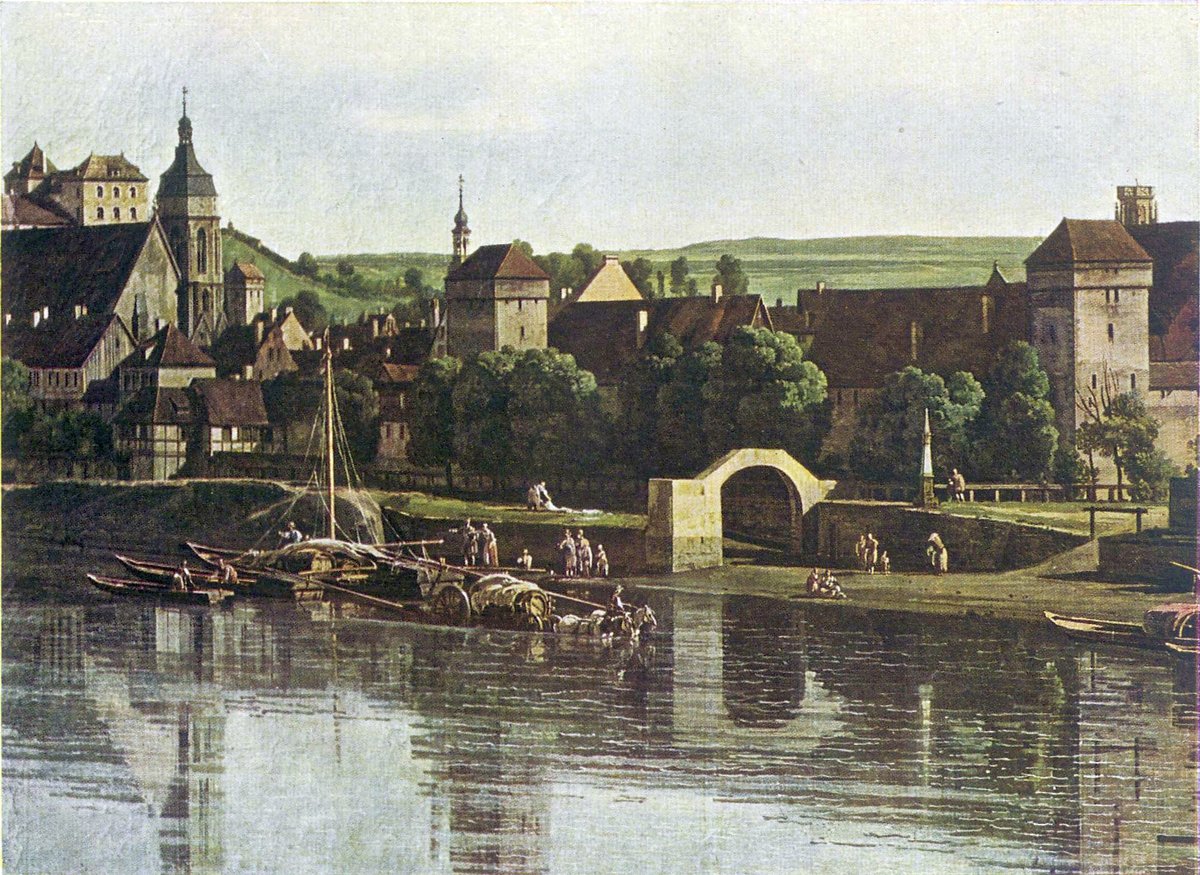
Polish-Saxon Post Milestone in Pirna: Comprehensive Visitor Guide
Date: 14/06/2025
Introduction
Nestled in the heart of Pirna, Germany, the Polish-Saxon Post Milestone is an enduring symbol of early 18th-century innovation in communication and transportation. Erected under Frederick Augustus I (Augustus the Strong) between 1721 and 1736, these milestones—known as Kursächsische Postmeilensäulen—were designed to standardize postal routes and fees across Saxony and its Polish territories. The Pirna milestone, located near the historic Dohna Gate and Market Square, not only guided couriers and travelers but also showcased Baroque artistry through its sandstone construction and heraldic details.
Today, the Polish-Saxon Post Milestone stands as a freely accessible outdoor monument, drawing visitors to Pirna’s pedestrian-friendly historic center. This guide provides detailed information on the monument’s history, architectural features, visiting logistics, and its integration into Pirna’s rich cultural landscape. Whether you are a history enthusiast, architecture lover, or simply exploring Saxony, this guide will help you make the most of your visit. (pagewizz.com, pirna.de, Commons Wikimedia)
Table of Contents
- Introduction
- Historical Background
- Architectural Features and Inscriptions
- Visiting Information
- Nearby Attractions and Travel Tips
- Preservation and Cultural Importance
- Frequently Asked Questions (FAQ)
- Conclusion
- References and Further Reading
Historical Background
Origins and Historical Context
The Kursächsische Postmeilensäulen were introduced in the early 18th century to address the need for standardized distances and postal fees across the Electorate of Saxony and its Polish territories under Augustus the Strong. These milestones, installed between 1721 and 1736, became essential waypoints, marking distances in Saxon miles and travel hours. Their establishment reflected the economic and political unity between Saxony and Poland, and underscored the era’s emphasis on precision and order in public infrastructure. (pagewizz.com; de.wikipedia.org)
Development and Design
Cartographer Adam Friedrich Zürner meticulously surveyed the region, ensuring that each milestone featured accurate distance measurements. Inspired by Roman milestones, the design and materials varied by location, with Pirna’s version crafted from local sandstone. These milestones were not only practical tools, but also served as symbols of state authority, adorned with coats of arms and regal inscriptions.
Function and Significance
Strategically located along principal trade and postal routes, these markers helped standardize postage rates and travel times. The Pirna milestone, in particular, underscores the town’s historic role as a vital hub within this postal network, linking key cities such as Leipzig, Dresden, and Breslau. (pirna.de; postmeilensaeulen-kursachsen.de)
Architectural Features and Inscriptions
The Polish-Saxon Post Milestone in Pirna is an elegant sandstone monument, standing approximately 2 to 3 meters tall. Its Baroque design includes a square or octagonal shaft, topped with a decorative finial and prominently displaying the coats of arms of Saxony and Poland. The initials “AR” (Augustus Rex) and the year of erection are inscribed, alongside precise distances to major cities such as Dresden and Warsaw, measured in Saxon miles (about 9.062 kilometers per mile). The inscriptions and sculptural details not only served practical needs, but also communicated the power and reach of the joint Saxon-Polish administration. (Commons Wikimedia)
Visiting Information
Hours and Tickets
- Visiting Hours: The monument is outdoors and accessible daily, year-round, 24 hours a day.
- Tickets: No tickets or entrance fees are required.
Accessibility
Located in Pirna’s pedestrian-friendly historic center near the Market Square and St. Mary’s Church, the milestone is accessible via paved paths. While the site itself is barrier-free, some surrounding cobblestone streets may require caution for visitors with mobility challenges.
Directions
- By Train: Regional trains connect Dresden Hauptbahnhof to Pirna in about 20 minutes. The monument is a 10-minute walk from the station.
- By Car: From Dresden, take the A17 motorway toward Prague and exit at Pirna. Public parking is available near the old town.
- By Bicycle: The Elbe Cycle Route passes through Pirna, making it a popular stop for cyclists. (Outdooractive)
Special Events and Guided Tours
Local tourism offices and the Pirna City Museum offer guided walking tours that include the milestone as part of broader historical routes. The monument is often featured during city festivals and heritage events. For up-to-date schedules, visit the Pirna tourism website or TouristService Pirna.
Nearby Attractions and Travel Tips
Top Historical and Natural Sites
- Pirna Old Town: Renowned for its Renaissance and Baroque architecture, vibrant market square, and inviting cafés.
- Sonnenstein Castle (Schloss Sonnenstein): A 13th-century castle with panoramic views over the Elbe.
- Saxon Switzerland National Park: Famous for dramatic rock formations, hiking trails, and the Malerweg (“Painter’s Way”).
- Bastei Bridge: A scenic sandstone bridge offering breathtaking views of the Elbe Valley. (Bastei Bridge)
- Museums: The Pirna City Museum and the Richard Wagner Museum (Graupa) illuminate local history and culture.
Practical Tips
- Best Time to Visit: Spring through early autumn offers pleasant weather and lively town events.
- Photography: The milestone is best photographed in the early morning or late afternoon. Its intricate details are especially striking with historic facades as a backdrop.
- Souvenirs: Postcards and literature about Pirna’s postal milestones are available at local shops.
- Public Transport: Day tickets for the Dresden transport network (VVO) cover travel to and within Pirna. (VVO)
- Refreshments: Sample Saxon specialties such as Eierschecke (cake) at nearby cafés.
Preservation and Cultural Importance
The Polish-Saxon Post Milestone is a designated protected cultural monument (Kulturdenkmal), maintained by local heritage organizations. Ongoing restoration and educational programs ensure the monument’s preservation and its continued relevance. The milestone represents not only a feat of historical engineering but also the enduring cultural ties between Saxony and Poland.
Frequently Asked Questions (FAQ)
Q: What are the visiting hours?
A: The milestone is accessible outdoors, 24/7, year-round.
Q: Is there an entrance fee?
A: No, visiting the Polish-Saxon Post Milestone is free.
Q: Are guided tours available?
A: Yes, guided tours are offered by the Pirna Tourist Information Office and City Museum.
Q: Is the site accessible for visitors with mobility challenges?
A: The monument is on level ground with paved access, though surrounding cobblestone streets may require caution.
Q: Can I take photographs?
A: Yes, photography is encouraged.
Conclusion
The Polish-Saxon Post Milestone in Pirna is more than a historical marker—it is a testament to the region’s role in shaping European communication networks and political alliances. Its preserved Baroque form and central location offer a tangible link to Pirna’s layered past. With free, year-round access and integration into city tours and heritage routes, the milestone is a rewarding destination for travelers, history buffs, and cyclists alike.
Plan your visit to experience this unique blend of history, architecture, and cultural vitality. For guided tours, event updates, and trip planning resources, consult the Pirna tourism website, TouristService Pirna, and digital tools like the Audiala app.
